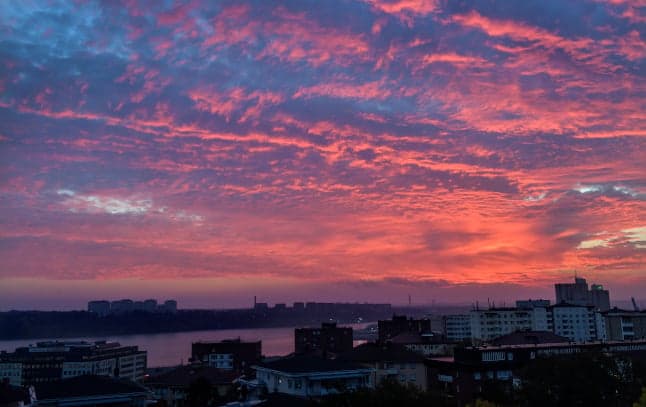Don't despair, the days are already getting longer in Sweden

The shortest day of the year has come and gone, and Sweden is heading towards brighter times.
This year, the winter solstice fell early on on Sunday morning, which means that from now on the days are getting longer and nights shorter. This is especially good news for the far north of Sweden, where many parts are experiencing polar nights at the moment – when the sun doesn't rise at all for several weeks.
"When we get to the middle of January, us in Kiruna will have gone from the sun barely rising to having days that have increased by more than three hours in length," Alexandra Ohlsson, meteorologist at Sweden's national weather agency SMHI, told the TT newswire.
The change happens more slowly further south. At around New Year's Eve, residents in Östersund in northern Sweden will have ten more minutes of daylight compared to now, while people living around Stockholm and futher south will have around five more minutes of daylight every day.
"But when we get to the last half of January the length of the day increases by on average four minutes a day," said Ohlsson.
The winter solstice falls when the Earth tilts the furthest away from the Sun on its axis. In the Northern Hemisphere this usually happens around December 21st-23rd every year.
For comparison, in Stockholm the sun was set to rise at 8.44am on Monday and set at 2.49pm. Six months ago on Midsummer's Eve, it rose at 3.32am and set at 10.06pm. These times will come again.
EDITOR'S PICKS:
If you think that the last couple of months have been darker than usual – and that's saying something in Sweden in winter – you are not completely wrong. The month of November was unusually grey, with only around 10 to 30 hours of sunlight in most parts of Sweden.
Lund in southern Sweden, which usually sees the sun peek out from behind the clouds for on average 52 hours in November, only got 20 hours this year. Stockholm, which usually has 54 hours of sunlight, got 33. Only ski resort Storlien performed better than the rest, with 47 hours of sunlight.
The lack of snow in much of Sweden this year – mostly southern and central parts of the country – also tends to make the winter feel darker. So even if you live further north and your days are shorter, they may in the end actually feel brighter thanks to what little light there is reflecting on the snow.
Vocabulary
sunrise – (en) soluppgång
sunset – (en) solnedgång
polar night – (en) polarnatt or (ett) midvintermörker
winter – (en) vinter
snow – snö
Comments
See Also
This year, the winter solstice fell early on on Sunday morning, which means that from now on the days are getting longer and nights shorter. This is especially good news for the far north of Sweden, where many parts are experiencing polar nights at the moment – when the sun doesn't rise at all for several weeks.
"When we get to the middle of January, us in Kiruna will have gone from the sun barely rising to having days that have increased by more than three hours in length," Alexandra Ohlsson, meteorologist at Sweden's national weather agency SMHI, told the TT newswire.
The change happens more slowly further south. At around New Year's Eve, residents in Östersund in northern Sweden will have ten more minutes of daylight compared to now, while people living around Stockholm and futher south will have around five more minutes of daylight every day.
"But when we get to the last half of January the length of the day increases by on average four minutes a day," said Ohlsson.
The winter solstice falls when the Earth tilts the furthest away from the Sun on its axis. In the Northern Hemisphere this usually happens around December 21st-23rd every year.
For comparison, in Stockholm the sun was set to rise at 8.44am on Monday and set at 2.49pm. Six months ago on Midsummer's Eve, it rose at 3.32am and set at 10.06pm. These times will come again.
EDITOR'S PICKS:
If you think that the last couple of months have been darker than usual – and that's saying something in Sweden in winter – you are not completely wrong. The month of November was unusually grey, with only around 10 to 30 hours of sunlight in most parts of Sweden.
Lund in southern Sweden, which usually sees the sun peek out from behind the clouds for on average 52 hours in November, only got 20 hours this year. Stockholm, which usually has 54 hours of sunlight, got 33. Only ski resort Storlien performed better than the rest, with 47 hours of sunlight.
The lack of snow in much of Sweden this year – mostly southern and central parts of the country – also tends to make the winter feel darker. So even if you live further north and your days are shorter, they may in the end actually feel brighter thanks to what little light there is reflecting on the snow.
Vocabulary
sunrise – (en) soluppgång
sunset – (en) solnedgång
polar night – (en) polarnatt or (ett) midvintermörker
winter – (en) vinter
snow – snö
Join the conversation in our comments section below. Share your own views and experience and if you have a question or suggestion for our journalists then email us at [email protected].
Please keep comments civil, constructive and on topic – and make sure to read our terms of use before getting involved.
Please log in here to leave a comment.